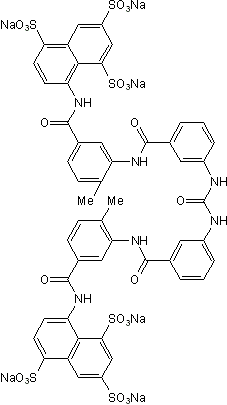Suramin hexasodium salt
Chemical Name: 8,8'-[Carbonylbis[imino-3,1-phenylenecarbonylimino(4-methyl-3,1-phenylene)carbonylimino]]bis-1,3,5-naphthalenetrisulfonic acid hexasodium salt
Biological Activity
Non-selective P2 purinergic antagonist. Also blocks calmodulin binding to recognition sites and G protein coupling to G protein-coupled receptors. Increases open probability of ryanodine receptor (RyR) channels. Also acts as a competitive α1β2γ2 GABAA receptor antagonist. Anticancer and antiviral agent.Technical Data
The technical data provided above is for guidance only.
For batch specific data refer to the Certificate of Analysis.
Tocris products are intended for laboratory research use only, unless stated otherwise.
Background References
-
Suramin is a novel competitive antagonist selective to α1β2γ2 GABAA over ρ1 GABAC receptors.
Luo et al.
Neuropharmacology., 2018;141:148 -
Inhibition of receptor/G protein coupling by suramin analogues.
Beindl et al.
Mol.Pharmacol., 1996;50:415 -
PPADS and suramin as antagonists at cloned P2Y- and P2U-purinoceptors.
Charlton et al.
Br.J.Pharmacol., 1996;118:704 -
Suramin and the suramin analogue NF307 discriminate among calmodulin-binding sites.
Klinger et al.
Biochem.J., 2001;355:827 -
Recent research on the biological activity of suramin.
Voogd et al.
Pharmacol.Rev., 1993;45:177 -
Functional regulation of the cardiac ryanodine receptor by suramin and calmodulin involves multiple binding sites.
Hill et al.
Mol.Pharmacol., 2004;65:1258
Product Datasheets
Reconstitution Calculator
Citations for Suramin hexasodium salt
The citations listed below are publications that use Tocris products. Selected citations for Suramin hexasodium salt include:
24 Citations: Showing 1 - 10
-
Connexin-43-dependent ATP release mediates macrophage activation during sepsis.
Authors: Dosch Et al.
Elife 2019;8
-
Mechanically stimulated ATP release from murine bone cells is regulated by a balance of injury and repair.
Authors: Mikolajewicz Et al.
Elife 2018;7
-
Role of purinergic signaling in experimental pneumococcal meningitis.
Authors: Zierhut
Sci Rep 2017;7:44625
-
Imaging extracellular ATP with a genetically-encoded, ratiometric fluorescent sensor.
Authors: Conley
PLoS One 2017;12(11):e0187481
-
In vivo Calcium Imaging of Evoked Calcium Waves in the Embryonic Cortex.
Authors: Yuryev Et al.
Front Cell Neurosci 2016;9:500
-
Signaling mechanism for modulation by ATP of glycine receptors on rat retinal ganglion cells.
Authors: Zhang Et al.
Sci Rep 2016;6:28938
-
Mitochondrial Dysfunction, Depleted Purinergic Signaling, and Defective T Cell Vigilance and Immune Defense.
Authors: Ledderose Et al.
J Infect Dis 2016;213:456
-
Antipurinergic therapy corrects the autism-like features in the Fragile X (Fmr1 knockout) mouse model.
Authors: Naviaux Et al.
Mol Autism 2015;6:1
-
Neuron-glia signaling in developing retina mediated by neurotransmitter spillover.
Authors: Rosa Et al.
J Mol Neurosci 2015;4
-
Stimulation-evoked Ca2+ signals in astrocytic processes at hippocampal CA3-CA1 synapses of adult mice are modulated by glutamate and ATP.
Authors: Tang Et al.
J Neurosci 2015;35:3016
-
Digoxin and adenosine triphosphate enhance the functional properties of tissue-engineered cartilage.
Authors: Makris Et al.
Tissue Eng Part A 2015;21:884
-
The Suramin Derivative NF449 Interacts with the 5-fold Vertex of the Enterovirus A71 Capsid to Prevent Virus Attachment to PSGL-1 and Heparan Sulfate.
Authors: Nishimura Et al.
PLoS Pathog 2015;11:e1005184
-
Diadenosine tetraphosphate contributes to CB-induced tear secretion.
Authors: Fonseca Et al.
Purinergic Signal 2015;11:87
-
Reversal of autism-like behaviors and metabolism in adult mice with single-dose antipurinergic therapy.
Authors: Naviaux Et al.
Transl Psychiatry 2014;4:e400
-
Antipurinergic therapy corrects the autism-like features in the poly(IC) mouse model.
Authors: Naviaux Et al.
PLoS One 2013;8:e57380
-
Neural progenitors organize in small-world networks to promote cell proliferation.
Authors: Malmersjö Et al.
J Pharmacol Exp Ther 2013;110:E1524
-
ATP release and autocrine signaling through P2X4 receptors regulate γδ T cell activation.
Authors: Manohar Et al.
J Leukoc Biol 2012;92:787
-
Blockade of P2 nucleotide receptors after spinal cord injury reduced the gliotic response and spared tissue.
Authors: Rodríguez-Zayas Et al.
Am J Physiol Heart Circ Physiol 2012;46:167
-
Purinergic receptors are required for HIV-1 infection of primary human macrophages.
Authors: Hazleton Et al.
J Immunol 2012;188:4488
-
A high throughput scintillation proximity imaging assay for protein methyltransferases.
Authors: Ibáñez Et al.
Comb Chem High Throughput Screen 2012;15:359
-
Constitutive lysosome exocytosis releases ATP and engages P2Y receptors in human monocytes.
Authors: Sivaramakrishnan Et al.
J Cell Sci 2012;125:4567
-
Critical role of aquaporin-4 (AQP4) in astrocytic Ca2+ signaling events elicited by cerebral edema.
Authors: Thrane Et al.
Proc Natl Acad Sci U S A 2011;108:846
-
Modulation of agonist binding to human DA receptor subtypes by L-prolyl-L-leucyl-glycinamide and a peptidomimetic analog.
Authors: Verma Et al.
Elife 2005;315:1228
-
Cannabinoid receptor-independent actions of the aminoalkylindole WIN 55,212-2 on trigeminal sensory neurons.
Authors: Price Et al.
Br J Pharmacol 2004;142:257
FAQs
No product specific FAQs exist for this product, however you may
View all Small Molecule FAQsReviews for Suramin hexasodium salt
There are currently no reviews for this product. Be the first to review Suramin hexasodium salt and earn rewards!
Have you used Suramin hexasodium salt?
Submit a review and receive an Amazon gift card.
$25/€18/£15/$25CAN/¥75 Yuan/¥2500 Yen for a review with an image
$10/€7/£6/$10 CAD/¥70 Yuan/¥1110 Yen for a review without an image

